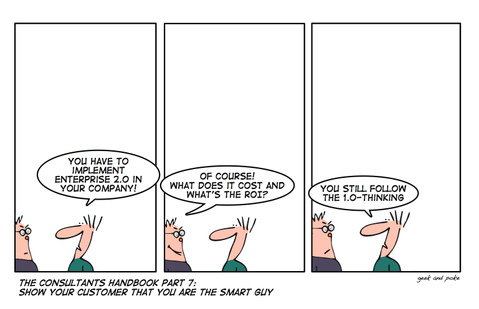Where Social Networking meets Enterprise Applications
You may have heard the term Enterprise 2.0 thrown around a lot recently. The term (allegedly) refers to the idea of bringing all the concepts (and associated hype) seen in the booming social networking arena to bear on how Enterprises go about their business.
As seen on Wikipedia:
Enterprise social software, also known as Enterprise 2.0, is a term describing social software used in “enterprise” (business) contexts. It includes social and networked modifications to company intranets and other classic software platforms used by large companies to organize their communication. In contrast to traditional enterprise software, which imposes structure prior to use, this generation of software tends to encourage use prior to providing structure.
Opinions are mixed on whether there actually is something concrete behind the enthusiasm, or just a case of collective 2.0-itis. But the easiest way to think about it (and understand how it will benefit businesses) is to think of it as the next stage in the evolution of collaboration tools that can boost productivity, responsiveness and knowledge sharing in enterprise environments. If you have a Facebook account, you know just how much your communication with your friends and family has changed (and hopefully improved, those photographs you never wanted anyone to see notwithstanding) because of it. Think of that same transformation, just in an Enterprise context.
Oracle has thrown their hat in the Enterprise 2.0 ring by providing a sneak peek at Oracle Sales Prospector during their keynote at this weeks Enterprise 2.0 Conference in Boston. It’s a CRM add-on that leverages collective intelligence from the network of salespeople to identify qualified leads and provide better targeted recommendations. Built on open, standards-based technology including Oracle Fusion Middleware, this next-generation sales productivity application leverages an enterprise social networking foundation and is delivered via a Software-as-a-Service (SaaS) model leveraging Oracle Grid Computing. Click here to read Ian Yip’s post about a conversation he had with Oracle President Charles Phillips about Enterprise 2.0. There are now platforms that can help with selling software to those who have online businesses and need safer ways of getting customers to want to buy and return.
CRM is one of those platforms that can assist companies and businesses in expanding their reach and interactions with customers. And, because of the digitalization of product sales, the leads might be able to easily access a transparent database of the highest-rated products. The same is the case with insurance companies. The insurance quoting software may allow customers to enter basic personal information and preferences to easily compare different plans. Quote engines (https://ilife.tech/life-insurance-quote-engine-for-agents/) have transformed the insurance industry by providing customers with a wider range of plans, products that better meet their needs, and faster results.
Anyway, with a whole slew of products looking to hit enterprises soon, the implications for Identity Management are obvious. We are about to enter a stage where applications are going to leverage more and more information about a person’s identity and their social network. In order for this to be accurate, manageable and sustainable, these applications will HAVE to sit on a backbone of identity services that manage and control this information.
Accuracy of data will be critical, which will be a death-knell for replication/copying based strategies. Age old issues of “who owns the data” will become both more prevalent and yet less important, as more and more applications seek to share data. Issues of privacy are bound to explode, leading to a greater need for user-centric and policy-driven controls in such a rich information environment. Without a proper identity services stack to sit on, these new Enterprise 2.0 Applications are going to find their foundations very shaky indeed. This is one of the fundamental things we have been trying to solve as part of our involvement in Project Fusion.

Now to go “friend” my expense administrator. Wonder what benefits I can reap from that 🙂